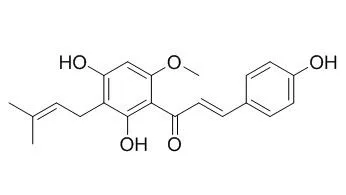| Kinase Assay: |
| Front Physiol. 2015 May 6;6:140. | | The hop constituent xanthohumol exhibits hepatoprotective effects and inhibits the activation of hepatic stellate cells at different levels.[Pubmed: 25999863] | Xanthohumol is the principal prenylated flavonoid of the female inflorescences of the hop plant. In recent years, various beneficial Xanthohumol effects including anti-inflammatory, antioxidant, hypoglycemic activities, and anticancer effects have been revealed.
METHODS AND RESULTS:
This review summarizes present studies indicating that Xanthohumol also inhibits several critical pathophysiological steps during the development and course of chronic liver disease, including the activation and pro-fibrogenic genotype of hepatic stellate cells. Also the various mechanism of action and molecular targets of the beneficial Xanthohumol effects will be described. Furthermore, the potential use of Xanthohumol or a Xanthohumol-enriched hop extract as therapeutic agent to combat the progression of chronic liver disease will be discussed. It is notable that in addition to its hepatoprotective effects, Xanthohumol also holds promise as a therapeutic agent for treating obesity, dysregulation of glucose metabolism and other components of the metabolic syndrome including hepatic steatosis.
CONCLUSIONS:
Thus, therapeutic Xanthohumol application appears as a promising strategy, particularly in obese patients, to inhibit the development as well as the progression of non-alcoholic fatty liver disease. |
|
| Cell Research: |
| Evid Based Complement Alternat Med. 2015;2015:921306. | | Xanthohumol induces growth inhibition and apoptosis in ca ski human cervical cancer cells.[Pubmed: 25949267] | We investigate induction of apoptosis by Xanthohumol on Ca Ski cervical cancer cell line. Xanthohumol is a prenylated chalcone naturally found in hop plants, previously reported to be an effective anticancer agent in various cancer cell lines.
METHODS AND RESULTS:
The present study showed that Xanthohumol was effective to inhibit proliferation of Ca Ski cells based on IC50 values using sulforhodamine B (SRB) assay. Furthermore, cellular and nuclear morphological changes were observed in the cells using phase contrast microscopy and Hoechst/PI fluorescent staining. In addition, 48-hour long treatment with Xanthohumol triggered externalization of phosphatidylserine, changes in mitochondrial membrane potential, and DNA fragmentation in the cells. Additionally, Xanthohumol mediated S phase arrest in cell cycle analysis and increased activities of caspase-3, caspase-8, and caspase-9. On the other hand, Western blot analysis showed that the expression levels of cleaved PARP, p53, and AIF increased, while Bcl-2 and XIAP decreased in a dose-dependent manner.
CONCLUSIONS:
Taken together, these findings indicate that Xanthohumol-induced cell death might involve intrinsic and extrinsic apoptotic pathways, as well as downregulation of XIAP, upregulation of p53 proteins, and S phase cell cycle arrest in Ca Ski cervical cancer cells. This work suggests that Xanthohumol is a potent chemotherapeutic candidate for cervical cancer. | | Planta Med. 2014 Feb;80(2-3):171-6. | | Inhibition of hepatitis C virus replication in vitro by xanthohumol, a natural product present in hops.[Pubmed: 24356905] | Hepatitis C virus is a major cause of chronic liver disease worldwide. Xanthohumol, a prenylated flavonoid from hops, has various biological activities including an antiviral effect. It was previously characterized as a compound that inhibits bovine viral diarrhea virus, a surrogate model of hepatitis C virus.
In the present work, Xanthohumol was examined for its ability to inhibit hepatitis C virus replication in a cell culture system carrying replicating hepatitis C virus RNA replicon.
METHODS AND RESULTS:
0.2 % DMSO and 500 units/mL interferon-alpha treatments were set as a negative and positive control, respectively. The inhibitory effect by Xanthohumol was determined by the luciferase activity of the infected Huh7.5 cell lysates and the hepatitis C virus RNA levels in the culture. Xanthohumol at 3.53 μM significantly decreased the luciferase activity compared to the negative control (p < 0.01). Xanthohumol at 7.05 μM further decreased the luciferase activity compared to Xanthohumol at 3.53 μM (p = 0.015). Xanthohumol at 7.05 μM or 14.11 μM achieved an inhibitory effect similar to that of interferon-alpha 2b (p > 0.05). Xanthohumol at 3.53 μM significantly reduced the hepatitis C virus RNA level compared to the negative control (p = 0.001). Although the results of Xanthohumol at 7.05 μM had a higher variation, Xanthohumol at the 7.05 μM and 14.11 μM decreased the hepatitis C virus RNA level to that achieved by interferon-alpha (p > 0.05).
CONCLUSIONS:
In conclusion, Xanthohumol displays anti-hepatitis C virus activity in a cell culture system and may be potentially used as an alternative or complementary treatment against the hepatitis C virus. |
|






 Cell. 2018 Jan 11;172(1-2):249-261.e12. doi: 10.1016/j.cell.2017.12.019.IF=36.216(2019)
Cell. 2018 Jan 11;172(1-2):249-261.e12. doi: 10.1016/j.cell.2017.12.019.IF=36.216(2019) Cell Metab. 2020 Mar 3;31(3):534-548.e5. doi: 10.1016/j.cmet.2020.01.002.IF=22.415(2019)
Cell Metab. 2020 Mar 3;31(3):534-548.e5. doi: 10.1016/j.cmet.2020.01.002.IF=22.415(2019) Mol Cell. 2017 Nov 16;68(4):673-685.e6. doi: 10.1016/j.molcel.2017.10.022.IF=14.548(2019)
Mol Cell. 2017 Nov 16;68(4):673-685.e6. doi: 10.1016/j.molcel.2017.10.022.IF=14.548(2019)